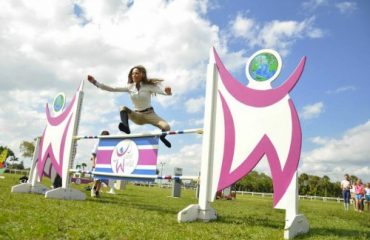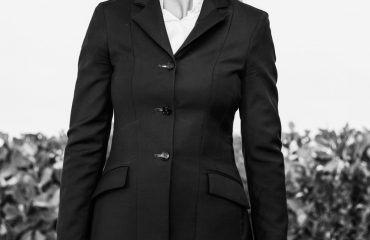By Lauren R. Giannini
Canadian artist Jennifer Mack isn’t like most horse painters. She perceives these magnificent creatures of energy and spirit as the epitome of freedom and always depicts them unbridled. Even on a 13-inch laptop, her horses, even the ones standing still, appear to explode off the screen in colors ranging from vivid to earth-toned. She paints in acrylics on canvas, in a style that can be described as realistic impressionism.
“I love doing commissions, which is about 50 percent of my work right now, and I’m happy as long as people know I’m going to paint their horse in my style,” Jennifer said. “I don’t do plain old portraits. I do contemporary fine art. For my other paintings, it’s actually more about relaxing with my eyes closed and imagining the piece of art. It’s a feeling, primarily. The horse is an excellent subject to portray feelings. I want people to look at my paintings and feel what they see.”
It takes her about three weeks to complete a painting. For commissions, she prefers to work from a photograph. She’ll drive two hours to take her own photos and will journey farther if clients pay the travel expenses. They can also send a photo if it includes what she needs to paint their horse accurately.
“I need to see the facial structures and the physical proportions of the body,” said Jennifer. “Sometimes people send a bunch of pictures of their horse and expect me to paint a composite, but I just don’t work that way. One good photo is all I need.”
Jennifer spends time preparing mentally before she begins every painting. “I think about what feeling I want to put out — be it strength, calmness, wild spirit,” she said. “I don’t just paint ‘the horse.’ I’m painting a feeling and I don’t always refer to photographs. When I’m painting a commission of someone’s horse, that’s the only time accuracy is important to me and then I work from a photo. Usually, people have at least one photo that they really like. I’ve been commissioned to paint a lot of horses that have passed, which is a real honor and I take it very much to heart.”
Childhood of Art & Riding
Jennifer grew up riding for fun on her family’s farm outside Calgary, Alberta, north of Montana. She was 8 when she started studying and drawing horses. As a teen, she competed in Western reining and showmanship. “I barrel-raced and did all the gymkhana events until I was 18,” she said. “Then I went to art school and didn’t have time to ride. My teachers also told me to stop drawing horses.”
Jennifer, who wanted to paint only horses, saw no point in taking classes devoted to other subjects, such as still life arrangements and the human form, to the dismay of her instructors. The prohibition on horses set in while she attended the Alberta College of Art & Design, in Calgary, and then Duncan of Jordanstone College of Art and Design, in Scotland, for seven years. As a result, she plunged into ceramics, textiles and mixed media, and also traveled the world before graduating from the Alberta College of Art & Design with distinction in 1994.
“Those were really important years for me,” Jennifer said. “Textile was about precision and craftsmanship. I’m trained as a weaver. There’s no room for a misthreaded warp thread or one mistake in the weft. I had a Japanese-trained dyeing and printing instructor who worked really hard to teach subtlety and patience. He advised me not to go to Japan, because I’m too ‘bull in china shop,’ but for someone who paints the way I do, his influence made it possible for me to be a successful professional artist. I’ve drawn horses full on since elementary school, so drawing horses wasn’t the hard part — it was making sure the craftsmanship is excellent and the subtle parts aren’t lost.”
Marching to her own drummer, Jennifer doesn’t cite many idols or mentors. She recalled an art history lecture about the use of colors in paintings by Henri Matisse, 19th century French artist.
“The teacher talked about how pinks and reds created vibration with turquoise and blues,” said Jennifer. “When I needed a way to express the rippling and mesmerizing images of the horses in the desert in Namibia, ‘pink and turquoise’ is what came up for me to get the visual ripple without distorting the horses’ images the way a mirage would. I suppose Matisse was a big influence on my early color work. Since I’m a self-taught painter, painting is a rule-free thing for me.”
Now and the Future
Jennifer trail rides Irish, her Rocky Mountain Saddle horse, in the foothills of the Rockies at least three times a week. She raised two daughters on her own, as a full-time artist. They’re both creative: one’s studying fashion design and the other’s training to be a commercial pilot. Jennifer works in her home studio daily, a combination of painting and paperwork. She sells original works and limited editions on her website and answers inquiries about commissions. She ships paintings to galleries and private customers, and pointed out: “There’s no duty on original art by Canadian artists entering the U.S., and shipping is easy.”
She has painted horses from one end of the color spectrum to the other. Her owls are portrayed with the same exuberance. Her canvases tend to be big.
“My art has evolved in terms of color,” said Jennifer. “I had that early bold red period, and I used to say I’d never paint a brown horse, but by saying never, I made sure I did that too and I loved the richness of the browns, blacks and cream. I want to re-visit my ‘bold fun vivid color’ era, see what the differences are. There will be more color coming soon, and I’ve spent the last year working on luxurious woven goods and ceramics — equestrian-themed cups, bowls and one-of-a-kind jewelry. I’m very excited about my expanded repertoire; beautiful new paintings and gifts will appear on my website for Christmas and beyond.”
For more information, visit www.jmackfineart.com.
Photos courtesy of Jennifer Mack



















